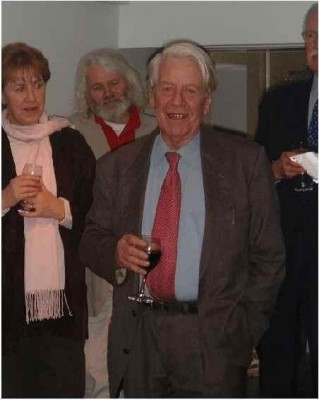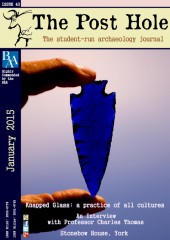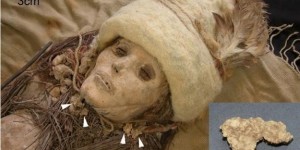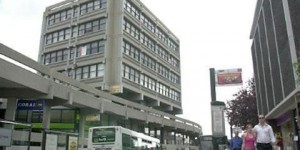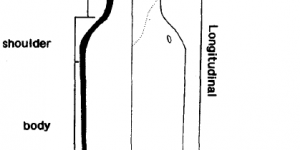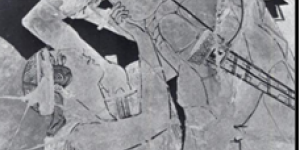Professor Charles Thomas is a noted and well-known academic, field archaeologist, author and military historian. His published work covers many of his archaeological interests and personal research, including Mesolithic, Roman, early Christian and Bronze Age archaeology. He also has an extensive knowledge and passion for the West Country, especially Cornwall and the Isles of Scilly.
This interview with Professor Charles Thomas was conducted at his fascinating home in Cornwall in an impressive library at the front of the building, which looked out onto some extraordinarily thick and knotted yew trees dating back to the 15th century. The house, he later informed me, was originally a Queen Anne house. Opposite us hanging above another doorway was half of a large wooden propeller, a gift from Charles's Uncle which had originally been part of a World War 1 aircraft. This is a transcript of an interview conducted with Professor Charles Thomas at Lambessow, Truro in September 2014.
What first triggered your initial interest in archaeology?
When I look back, I have found that it was not any particular single event which first got me interested in archaeology. It was more of a long, sideways approach which led to it. I first discovered my interest in heritage though when I was eight years old. I had been attending a preparatory school in Devon when my brother contracted measles. Because this was the time before immediate vaccinations to prevent this kind of thing, I was put under quarantine at my grandfather’s house, where I spent some time in his library. It was here that I alighted upon my grandfather’s book collection, and began to read and become interested. In particular, I remember a volume on Cornish linguistics and local history, which I found to be fascinating.
|
At the end of World War II you served in the British army in Egypt. Did you find that this affected your archaeological interests?
Yes, I joined the British army in 1945 when I was 17 and served in Egypt for two years. It was a wonderful place and very hot! During our spare time from training, I used to pick up flint from places like Luxor and Aswan, which also heightened my interest in archaeology. It was here that I learned to speak colloquial Arabic too, through learning essential phrases such as asking for the prices of things.
So how did you begin studying archaeology?
Well, I actually read law at Oxford University in 1948, as I came from a family of solicitors, like my father and grandfather and so continued in their footsteps. Near to my university however, was a book shop called Blackwell’s – I hope very much that it’s still there; it was a fantastic place with tall leaning towers of books that you had to sort through to find what you wanted to read. It was here that I alighted upon copies of some of Gordon Childe’s and Richard Atkinson’s work, and became very interested. In 1950, I joined excavations on two sites: the hut circles at Carwynnen and Godrevy barrow, both in West Cornwall. It was here that I became an editor for the West Cornwall Field Club, where I met some real archaeologists for the first time. In 1951 I had a second attempt at my third degree (law was not a favourite area of mine!). After completing my degree as my family wanted me to do, I then wrote to Professor Gordon Childe who was tutoring at the Institute of Archaeology, who accepted my request and I became a student of his. Other students of his included Paul Ashby and Nicholas Thomas. I later moved to Cornwall and became a tutor myself.
During your archaeological career, you met many well-known archaeologists like Mortimer Wheeler and Gordon Childe. Did you find that they influenced you?
Yes, I knew both of these men! They were both such characters, but in different ways.
It was excellent to be Gordon Childe’s pupil – we all loved him! He was a quiet, nice, shy, eccentric man; a little strange and very kind. It was also because of him that I became proficient in several languages such as French, German, Italian and Spanish, as well as being able to read Portuguese, as he would set us reading that had not yet been translated into English, and would ask us to translate papers that we were reading for him, such as papers covering folklore from Spain, etc. Aside from being my tutor for a while, Professor Gordon Childe was also an acquaintance of my Australian grandmother.
Mortimer Wheeler was also a brilliant archaeologist, but a completely different kettle of fish – he was quite the womaniser! He was also quite vain, and wore a male corset!
I also knew Glyn Daniel, the charismatic presenter of the Animal, Vegetable, or Mineral television series in the 1950s . I did actually feature in one of these programmes. He was also a lovely man, very nice and extremely funny! I was also good friends with Philip Rahtz and Leslie Alcott. I knew Sir Barry Cunliffe and John Coles too.
You have done work with Stuart Piggott in Edinburgh – what was this like?
Yes, in 1958. He was a close friend of mine – we both shared a house with another friend of ours – Richard Atkinson (who later went on to excavate Silbury Hill and Stonehenge). We were all extremely short on funds at this time!
How did your career develop from that point onwards?
Well in 1967 I gained a Professorship at the University of Leicester, and moved there with my wife and 3 children who had been born in Scotland. In 1971-72 I became president of the Council of British Archaeology. I was then the first Professor of Cornish studies. I also spent 14 years as acting chairman of the Royal Commission on the Historic and Ancient Monuments of England (RCHME).
Out of all your archaeological projects, of which ones are you the most proud?
It would definitely be my excavations done at Gwithian on the West coast of Cornwall, where we discovered the first ever traces of Bronze Age ploughmarks, something that had never before really been considered. I am also very proud of our work on the Mesolithic coastal sites from all around the Cornish Coast – I was actually inspired by, Cambridge Professor, Grahame Clark’s work on the Mesolithic which got me interested, perticularly the Cornish coastal sites, especially at Gwithian.
I am also proud of our work at Tintagel, where we looked at post-Roman imports of amphorae from the Mediterranean. The site was visited by C. A. Raleigh Radford in the ‘90s after his work here in the 1930s.
What do you think of the popular interest in archaeology? Do you think there should be more public awareness of the past?
Ha! The English Heretics! And Time Team is often very unrealistic. The representation of archaeology to the masses is, unfortunately quite often fantastical, and not very well researched. It is very important that archaeology in the media is well explained without being commercialised.
What do you consider to be the most important development in archaeology in the last 50 years or so?
That definitely has to be radiocarbon dating, and other forms of acquiring accurate dates for things too, especially with Chris Stringer’s work on Palaeolithic dating.
Of all the time periods which you have worked in, which have grabbed your interest the most?
My answer is split between the Mesolithic period around the coastlines, and the Early Christian time of 5-8th century AD, especially in relation to maritime contacts between Cornwall and the Mediterranean.
After the interview was completed, we chatted for a while about some of the many interesting features of his house. I would like to thank Charles for welcoming me into his beautiful home, telling me about some of the history of the house and its fascinating decor, and agreeing to take part in this interview.


